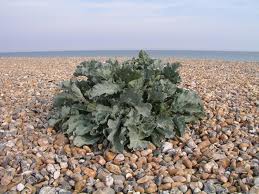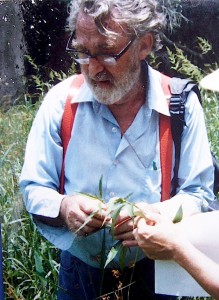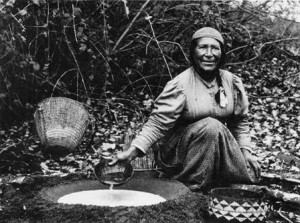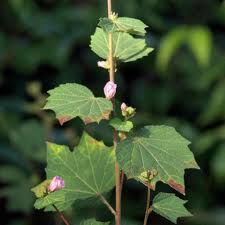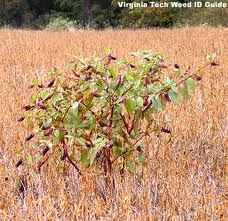For a surprisingly simple question there is often a complicated answer. If it’s sea kale, then the answer is yes, top to bottom. It is edible. It is doubtful anyone has ever died from eating sea kale. If the plant is poison hemlock, then no it is not edible. You’ll be dead before it leaves your stomach for the small intestine. Between these two are all the other plants.
I had a foraging friend, Dick Deuerling, who passed in July, 2013, at at 92. When it came to wild plants he would say “I only eat the good stuff.” Well… like the word “edible” what is “good”? And how many wild plants are edible, and good and how many are toxic? It depends upon the definitions.
If you were to look at an average 20 acres on an average place on earth with average rainfall and temperatures you might find an average of 5 to 10 percent of the species edible. Shall we split the difference at 7.5%. This will vary with more edibles at the equator and much less in the tundra but nearly every plant in the tundra is edible. It is far more efficient to learn the edible plants than the non-edible ones. Then there is the issue of poisonous ones. Again it depends upon the definition (though I have read there are no poisonous plants in the tundra.)
I can remember the first time I heard someone refer to acorns as poisonous. To me they were just bitter because of tannic acid. Yet, if you did manage to eat a lot of acorns with tannic acid you would be sick, probably not deathly sick but ill nonetheless. (Incidentally, man has not been totally successful at breeding the bitterness out of the acorn.) So there is a range with “toxic” plants, those that make you mildly ill to those that can kill you within a few minutes, seconds if refined. Which brings me to a plant like the Urena lobata.
I debated whether I should to put the U. lobata on my site or not, whether to do a video on it or not. Even when cooked the young leaves have disagreeable texture. It is like eating sandpaper that turns to sand and then is finally swallowable. Edible, nutritious, but not good or tasty. Yet it sustains people and its roots are very medicinal. So I put it in the famine food category.
Let’s take this a step further. Pokeweed is a good example of a common plant which if prepared incorrectly will kill you. There is no way to sugar-coat that reality. Harvest it wrong, prepare it wrong and you can easily be dead. Yet, it is a delightful green of spring when prepared correctly. It is September as I write and I still have poke in my freezer from last April.
Last night I read that the American Natives showed settlers how to cook pokeweed. I’d like to know if that is a fact or an assumption. The natives called the plant “red” because of the color of its stalk. They also used it medicinally. Eating it was a different issue. The Alabama tribes noted that white settlers ate the young leaves but the Alabamans did not. So, why doubt whether the American Indians taught the white man how to cook the pokeweed?
Poke should be boiled at least twice to get rid of the toxins. Boiling has not been among man’s cooking choices for too long. Before metal most boiling was done in dug out logs or skin bags with hot rocks. In North America clay pots for boiling didn’t come into being until about 2,000 years ago. No matter how done boiling was a laborious affair usually reserved for big game. Cooking pokeweed, which required two boilings for very little caloric payoff, was doubtful. Pokeweed as a food did not come into its own until humanity had a relatively quick and easy way to boil water. Metal pots was the foremost request the Europeans had from the native population. If natives did not boil much before that it would mean that pokeweed has been a “food” for man for only a split second of his history. Said another way, if we were hunters and gathers from 10,000 years ago we probably would not be eating pokeweed, or cashews, or tapioca, or cassava or even many beans. In fact, we probably were not eating dandelion tops — too bitter — but were roasting the roots in the fire.
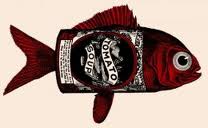 Thus we eat many wild foods that were not eaten long ago in the absence of boiling. We also eat a lot of contemporary plants there were not food in the past: Orange carrots, sweet apples, red peppers, cauliflower…tomatoes with flounder genes…. the list is long. We eat a lot of things — wild and cultivated — we did not eat 10,000 years ago. While perhaps not toxic is this food we were designed or evolved to eat? Might our ancestral diet be important?
Thus we eat many wild foods that were not eaten long ago in the absence of boiling. We also eat a lot of contemporary plants there were not food in the past: Orange carrots, sweet apples, red peppers, cauliflower…tomatoes with flounder genes…. the list is long. We eat a lot of things — wild and cultivated — we did not eat 10,000 years ago. While perhaps not toxic is this food we were designed or evolved to eat? Might our ancestral diet be important?
That all makes the question like “is this plant edible?” rather tough in many cases. A few are clearly yes, a few are clearly no, and in between there there can be a lot of fog. What about a tomato with a flounder gene? (So it can withstand cold better.) Has it been eaten by large numbers of humans for many centuries to prove it is safe? How about the pokeweed for that matter? Is there a higher cancer rate among pokeweed eaters like those who boil and can fiddleheads? Pokeweed has mitogens and those promote cell division. Then again, I eat poke only a few times every year, where as I can eat a fish tomato daily, or a diet soda, or processed cheese food with more additives than a Christmas chemistry set.
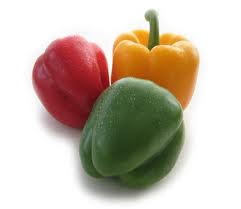 What about the foods that are considered really safe, a yellow pepper for example. How long has it been around? It actually comes from a rather toxic family. How many people have to eat it over how many years to prove it’s actually safe? Much produce is now hybrids, meaning if man did not make them they would disappear off the grocery shelf. Nature rarely hybridizes. Are these hybrids really safe? Indeed, most of the produce in a produce section was not around in its current form a few centuries ago. They are not as estranged from the human diet as the fish tomato but they are not what our ancestors ate. And if that is not confusing enough we get products taken off the market as toxic when that is very doubtful. Sassafras is an excellent example. The amount of safrole in an old fashion glass of root beer was less harmful than the alcohol in a glass of real beer. Yet safrole is now highly controlled. In short, our foods are highly manipulated, and what is good may not always be good and what is bad may not always be bad. I am mighty doubtful of the chemist in the kitchen.
What about the foods that are considered really safe, a yellow pepper for example. How long has it been around? It actually comes from a rather toxic family. How many people have to eat it over how many years to prove it’s actually safe? Much produce is now hybrids, meaning if man did not make them they would disappear off the grocery shelf. Nature rarely hybridizes. Are these hybrids really safe? Indeed, most of the produce in a produce section was not around in its current form a few centuries ago. They are not as estranged from the human diet as the fish tomato but they are not what our ancestors ate. And if that is not confusing enough we get products taken off the market as toxic when that is very doubtful. Sassafras is an excellent example. The amount of safrole in an old fashion glass of root beer was less harmful than the alcohol in a glass of real beer. Yet safrole is now highly controlled. In short, our foods are highly manipulated, and what is good may not always be good and what is bad may not always be bad. I am mighty doubtful of the chemist in the kitchen.
Now when I am asked is that plant edible I say humans have been eating it for a long time, or a short time, almost no time, or not at all. Occasionally I can say they ate it in the past but not today. The longer I study plants, and forage, and the more I eat and the older I get, the more I am convinced how they ate thousands of years ago, and what they ate, was better and healthier than today.

